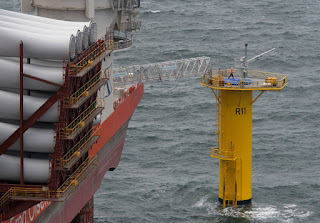Analysts forecast a sixfold increase in offshore wind power capacity by 2030, but while Europe's market booms, U.S. growth has been slow. That may be changing.
Transporting an offshore wind array from the factory floor to the ocean floor is no easy feat. Giant, specialized marine vessels must carry the blades and turbines—which sit atop rigs hundreds of feet tall—out miles from shore. Steel or concrete foundations are built to hold them in place, and underwater cables are laid on the seabed to transfer the power to land.
One other industry has spent decades constructing and maintaining such massive energy infrastructure that can survive the storms of the open ocean: oil and gas. Now, with global demand for wind power growing, major oil and gas companies like Shell and Statoil are diversifying their portfolios by developing offshore wind, and the companies that provide services to offshore fossil fuel platforms are seeing a new market rising in their wake.
"Offshore wind developing seemed like a natural skill set for offshore oil and gas companies," said Stephen Bull, senior vice president of wind and carbon capture storage for Statoil, a Norwegian oil and gas company. "From the Gulf of Mexico to Brazil and beyond, we see a similar supply chain and skill set and can grow within this area."
Statoil, which is building the world's first floating wind farm near Scotland, is planning development for its first offshore wind lease in the U.S., an 80,000-acre area off the coast of New York that could generate more than a gigawatt of power. Ørsted (formerly DONG Energy, short for Danish Oil and Natural Gas), has a 1.3 gigawatt wind farm under construction off the UK and is exploring developments off Massachusetts and New Jersey. Shell is leading the development of two wind farms in the Dutch North Sea.
Globally, 17.6 gigawatts of wind power capacity have been installed offshore, with most of it in Europe, and the industry is growing. Bloomberg New Energy Finance raised its offshore wind forecast this week, with an expectation that it will reach 115 gigawatts worldwide by 2030.
...
According to a 2017 Wood Mackenzie study, annual revenues from wind and solar could represent one-twelfth of the revenues in oil and gas by 2035. As major global oil and gas companies and supply chain companies are moving into the offshore wind game, the market is ripe for large-scale projects that could not only generate more wind power in the U.S. but bring costs down and create jobs in local communities.
"Building on the success of the oil and gas industry and their work in the open ocean for several decades now, we think it's a great business opportunity for them," said Nancy Spoko, director of offshore wind and federal legislative affairs at the American Wind Energy Association. "And it's a great starting point for offshore wind to utilize the skilled workers, infrastructures, the vessels and the body of expertise that comes from oil and gas to catapult another new ocean industry resource."
...
Using Oil and Gas Industry Strengths
Just south of Rhode Island, the only working offshore wind farm in the U.S. has been successfully supplying power from five turbines to about 2,000 customers for just over a year. Years ago, Europe started with small projects like that, Bull said. But as oil and gas giants entered the market, they have been able to take on larger projects that generate more electricity. Since then, Europe has become the world leader in offshore wind, with about 13 gigawatts installed and more in the works.
"What we see now has scaled dramatically on the industrial level—turbines are much larger and farther from shore to capture better resources," Bull said. "Oil and gas companies are used to carrying that kind of investment."
Oil and gas supply chain companies are also getting into the market.
Gulf Island Fabrication, based in southern Louisiana, manufacturers foundations for offshore oil rigs—and for offshore wind turbines. The company built foundations modeled after oil platforms for the Block Island Wind Farm.
The Houston-based engineering firm Zentech, which specializes in rig platforms and offshore oil drilling and construction vessels, announced plans this summer to tackle another hurdle facing the wind industry: with Renewable Energy Resources International of Virginia, the company is building the first U.S. offshore wind-turbine installation vessel. Under the Jones Act, only U.S.-built, U.S.-based ships with U.S. crews can carry goods between U.S. ports. When the Block Island Wind Farm was built, a European ship had to be used, and it wasn't allowed to dock in the U.S. before delivering supplies. After some "fine-tuning" of the designs, the new U.S. vessel is on track to be completed by mid-2019, Zentech Vice President Sundaram Srinivasan said.
The wind industry provides an opportunity for companies to reinvent themselves and diversify, Bull said, and for employees to find work in a new market. "These workers have been building things for open ocean use for decades," he said, adding that he's hoping American offshore oil supply chain companies will get into the offshore wind industry to help create local jobs.
Read more at Oil Giants See a Future in Offshore Wind Power. Their Suppliers Are Investing, Too.


No comments:
Post a Comment